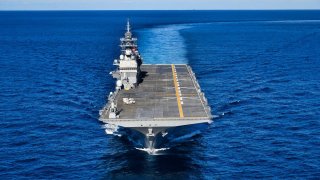Japan's New 'Aircraft Carrier' Is Coming to America for F-35 Training
Japan is sending its modified Izumo-class helicopter carrier, JS Kaga, to the U.S. West Coast for flight operations with the F-35B Lightning II between October and November 2024. Some experts consider the vessel a quasi-aircraft carrier.
Summary and Key Points: Japan is sending its modified Izumo-class helicopter carrier, JS Kaga, to the U.S. West Coast for flight operations with the F-35B Lightning II between October and November 2024. Some experts consider the vessel a quasi-aircraft carrier.
-This follows Japan's strategic move to upgrade its Izumo-class vessels to operate fixed-wing aircraft. Though officially termed "multi-purpose operation destroyers" to align with Japan's pacifist constitution, the modifications bring them closer to aircraft carriers.
-JS Kaga will undergo tests off San Diego, marking a significant step in Japan's defense strategy under its reinterpreted constitution, allowing for "collective self-defense."
-China's concerns about Japan's military resurgence have heightened with these developments.
Japanese Aircraft Carriers Are Heading to the West Coast
One of the two Japan Maritime Self-Defense Force (JMSDF) modified Izumo-class helicopter carriers will be heading to the United States, where it will engage in flight operations with the Lockheed Martin F-35B Lightning II.
JS Kaga (DDH-184) will assess its "ability to operate" the short take-offs and vertical landings (STOVL) fifth-generation fighter in "developmental tests… scheduled to take place between October 5 and November 18, 2024, off the coast of San Diego," Army Recognition reported on Tuesday. The U.S. military will be supporting the tests.
The United States Marine Corps had previously conducted STOLV exercises on JS Izumo (DDH-183) in October 2021. "U.S. Marines embarked aboard the JS Izumo and worked directly with JMSDF personnel as part of a bilateral effort to ensure the capability test was both effective and safe," the service previously announced.
JS Kaga is about to begin its Indo-Pacific Deployment 2024, the first since it underwent the modifications that enabled it to operate the fifth-generation multirole stealth fighter.
Carrier Transmission Explained
The post-World War II Japanese constitution renounced war as the sovereign right of the nation, and armed forces with war potential would not be maintained. That constitution is also notable in that it hasn't been amended since its implementation in 1947.
However, it has been a matter of semantics when it comes to aircraft carriers.
The JMSDF has operated the JS Izumo and JS Kaga multi-role flattops since 2013 and 2015 respectively. Throughout their service to date, the two warships may resemble modern aircraft carriers but were officially described by Tokyo as a "multi-purpose operation destroyer" due to their main purpose being to seek out and destroy enemy submarines in the self-defense of Japan.
However, the vessels have each begun a two-stage transformation that will allow them to operate fixed-wing aircraft – notably the F-35B Lightning II. JS Izumo has undergone its initial modification stage. That has included the application of heat-resistant paint to its flight deck – suggesting it is far easier to change the capabilities of a warship than it is to modify the Japanese constitution.
JS Kaga has seen the modification of its bow section that has earned comparisons to the U.S. Navy's Wasp-class and America-class amphibious assault ships, which also operate with the F-35B.
According to Naval News, "The first-stage modifications also include reinforcing the flight deck to support additional weight, placing additional guidance lights, drawing the yellow lines on the flight deck necessary for launching and landing F-35Bs, and fitting the ship with heat-resistant deck spots for vertical landings."
Yet, despite these modifications of the vessels, Tokyo remains cautious in its exact terminology, refraining from explicitly labeling the modified Izumo-class vessels as aircraft carriers. That decision aligns with the nation's long-standing defensive security policies under the pacifist constitution.
Instead, in 2014, then-Prime Minister Shinzo Abe approved a reinterpretation of Article 9, which allowed Japan to exercise the right of "collective self-defense," in some instances, and even to engage in military action if one of its allies were to be attacked.
Beijing has expressed concerns over Japanese remilitarization efforts, including its decision to operate what are essentially " mini-aircraft carriers" in everything but name.
Author Experience and Expertise: Peter Suciu
Peter Suciu is a Michigan-based writer. He has contributed to more than four dozen magazines, newspapers, and websites with over 3,200 published pieces over a twenty-year career in journalism. He regularly writes about military hardware, firearms history, cybersecurity, politics, and international affairs. Peter is also a Contributing Writer for Forbes and Clearance Jobs. You can follow him on Twitter: @PeterSuciu. You can email the author: [email protected].
Image Credit: Creative Commons and/or Shutterstock.


